Maps and Locations Chapter Notes | Mathematics (Maths Mela) Class 5 - New NCERT PDF Download
| Table of contents |

|
| Finding Directions |

|
| Map of a Room |

|
| Zoo Trip |

|
| Coordinates |

|
Finding Directions
Do you know one simple way to find directions without using a compass? Let’s try this fun activity together!
Steps to be followed:
1. Go outside early in the morning or imagine you are standing in a field.
2. Now, face the rising sun. The direction you are facing is called East. The sun always rises in the East!
3. Stretch out your arms to your sides.
- Your left hand is now pointing towards the North.
- Your right hand is pointing towards the South.
- And the direction behind you is West – that’s where the sun sets.
You’ve just found all four cardinal directions — East, West, North, and South — just by facing the sun! Isn’t that cool?
Remember:
Let us perform some activities to understand directions better:
1. Observe the picture above and answer the following:
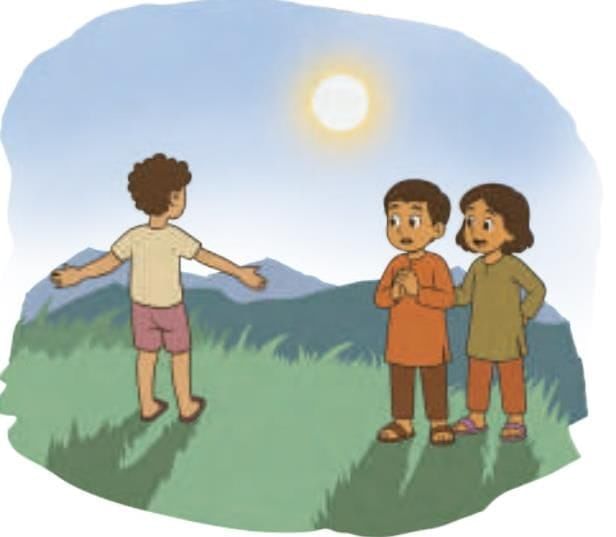
Manu is facing the rising Sun. That direction is East. His left hand is pointing in the North direction. His right hand is pointing in the South direction. West is behind him.
Map of a Room
What is a Compass?
- A compass is a small tool that helps us find directions.
- It has a magnetic needle that always points towards the North.
- Once we know where North is, we can easily find South, East, and West too.
- People use compasses while travelling, hiking, sailing, or exploring new places.
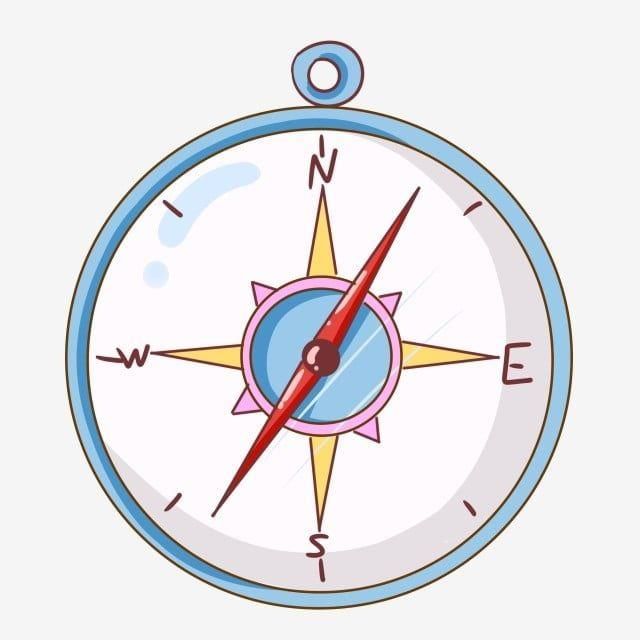
Write the directions of the following with the girl.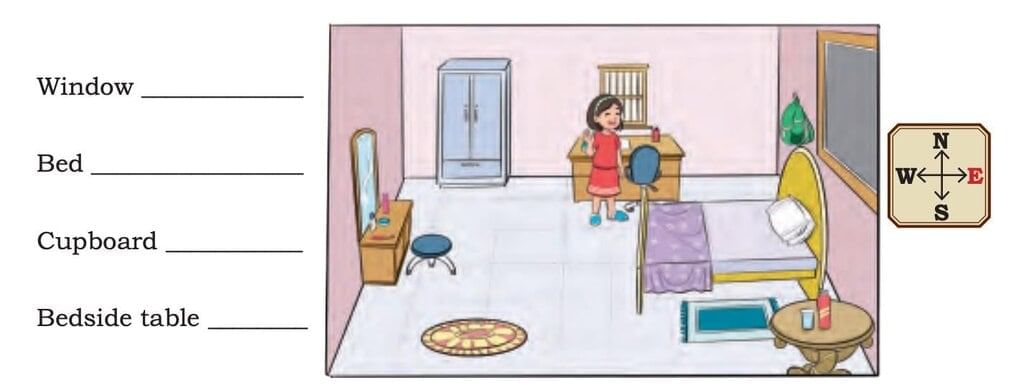
Ans:
Window — North
Bed — East
Cupboard — West
Bedside table — South
Zoo Trip
What are Maps?
- A map is a special drawing that shows places like streets, parks, schools, or a zoo.
- Maps help us find places, plan routes, and know directions.
- A map shows:
- Places – houses, roads, parks, shops, monuments.
- Symbols – small pictures or signs for things.
- Directions – an arrow showing North (N) helps us find East, West, and South.
- Routes – lines or paths to go from one place to another.
- Key/Legend – a box that explains what the symbols mean.
1. The street map shows the bus route with dotted lines. The bus will pick up children from Stop 1 and Stop 2 marked on the map.

Observe the map and help the children board the bus.
The bus will start from the parking area. It will go north and then it will take a right turn onto ___________ Road driving in the ___________ direction to reach Stop 1(S1). To reach Stop 2(S2), it will turn _______ (right/left) onto ___________ Road driving in the ___________ direction.
Ans: The bus will start from the parking area. It will go north and then it will take a right turn onto Market Road driving in the east direction to reach Stop 1 (S1). To reach Stop 2 (S2), it will turn left onto Temple Road driving in the north direction.
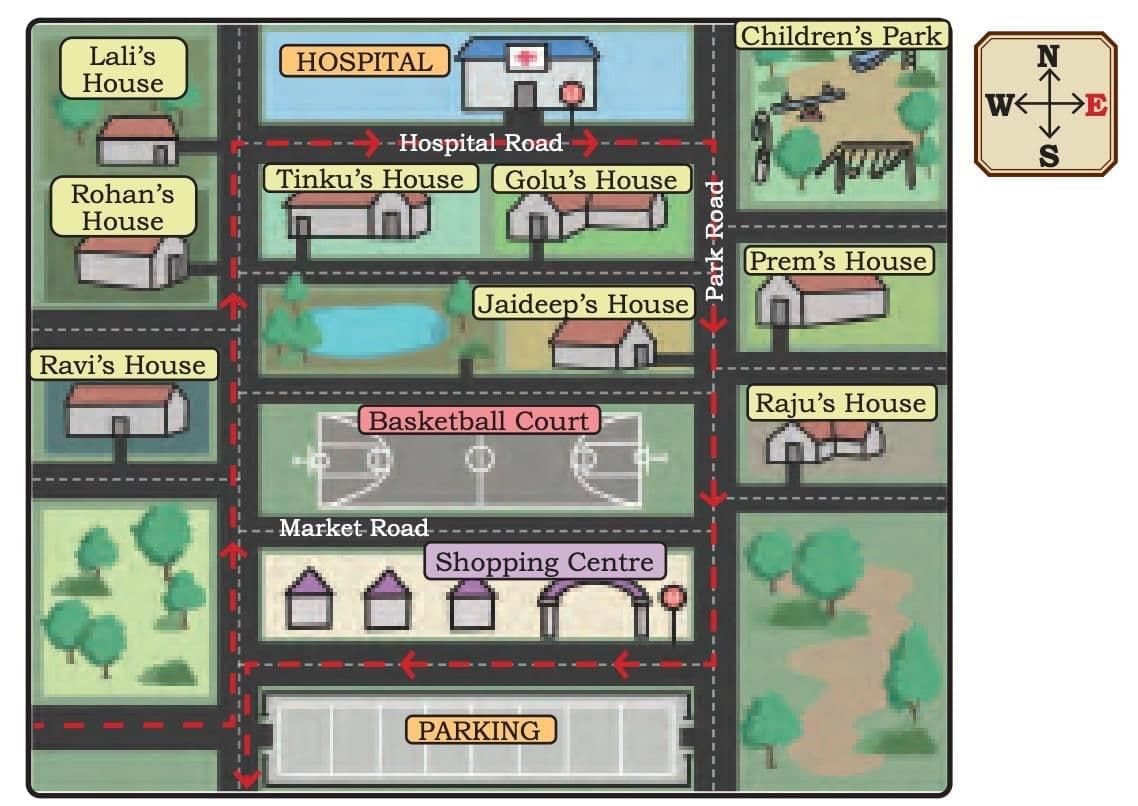 Bus Route
Bus Route
(a) Whose houses are situated to the east of Jaideep’s house?____________
(b) Mark the route from Ravi’s house to the children’s park.
(c) Which stop is closer to Lali’s house? __________________
(d) Golu is running late. Trace the route to help him reach the nearest bus stop.
(e) In which direction would Prem have to move to reach Stop 2?
Ans:
(a) Raju’s house and Prem’s house
(b) From Ravi’s house → go north on Hospital Road → turn east to reach Children’s Park
(c) Stop 1 (S1)
(d) From Golu’s house → go north on Market Road → turn east to reach Stop 1 (S1)
(e) North
Keys/Legends in a Map
- A Key or Legend in a map is like a dictionary of symbols.
- Maps use small pictures, lines, or colours instead of writing everything.
- The Key/Legend tells us what each symbol means.
Children will get off the bus at the Qutub Minar metro station. To reach the zoo, they need to get off the metro at the Supreme Court metro station. Here is the metro map for your reference. Read the key to the symbols and identify them on the map. What do the different coloured lines represent? Mark the Qutub Minar station on the Yellow Line and the Supreme Court station on the Blue Line.
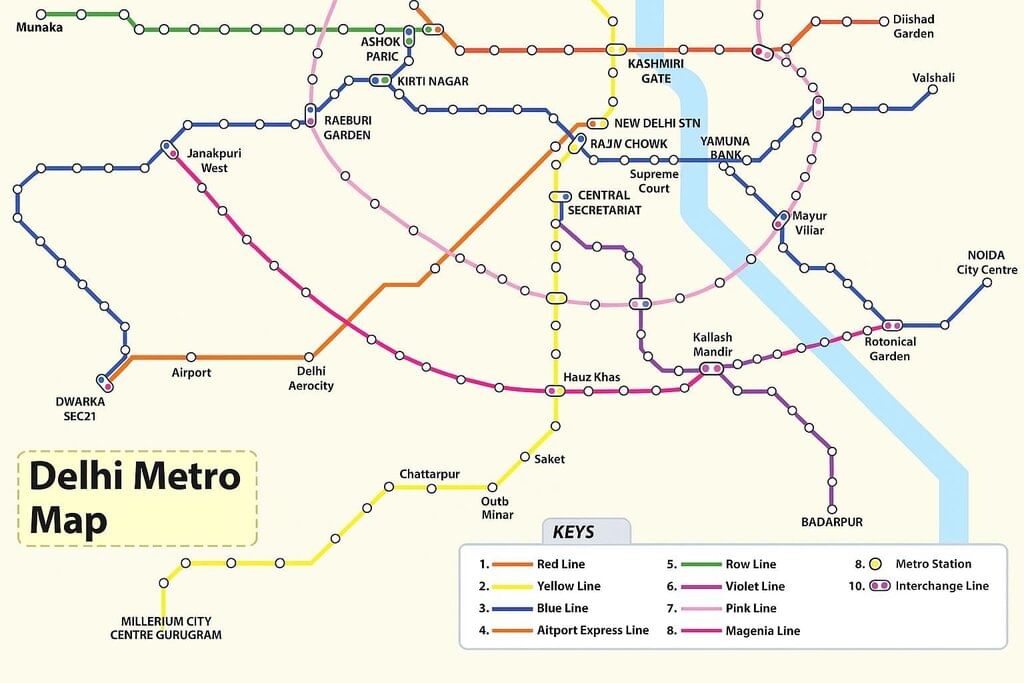
Study the map carefully and answer the questions that follow.
(a) Look at the metro map and trace different routes from the Qutub Minar metro station to the Supreme Court metro station.
(b) Lali says, “We can take the Yellow Line and change the metro at Hauz Khas to take the Magenta Line.” If the children follow Lali’s suggestion, at which station(s) do they need to change the metro line again to reach the Supreme Court metro station?
(c) Which route has the least number of stations between Qutub Minar and the Supreme Court?
(d) Which metro route(s) do you think, is/are the best way to reach the zoo from Qutub Minar? __________________________
Ans:
(a) Possible routes from Qutub Minar (Yellow Line) to Supreme Court (Blue Line):
- Route 1:
Qutub Minar (Yellow) → Central Secretariat (Interchange) → Supreme Court (Blue)- Route 2 (via Rajiv Chowk):
Qutub Minar (Yellow) → Rajiv Chowk (Interchange) → Supreme Court (Blue)- Route 3 (via Hauz Khas & Magenta Line):
Qutub Minar (Yellow) → Hauz Khas (Interchange to Magenta) → Janakpuri West (Interchange to Blue) → Supreme Court(b) If Lali’s suggestion is followed:
- First change: Hauz Khas (Yellow → Magenta)
- Second change: Janakpuri West (Magenta → Blue)
(c) The shortest route (fewest stations):
- Qutub Minar → Central Secretariat → Supreme Court (only 1 change)
(d) Best route:
- Qutub Minar (Yellow) → Central Secretariat (Change to Blue) → Supreme Court
- Reason: This is the shortest, simplest route with only one interchange and minimal travel time.
Shortest Route
- Sometimes, there are many paths to reach the same place.
- For example, to go from your home to school, you may have:
- A long road around the park.
- A short road through the market.
- Both roads reach school, but the one that takes less time and distance is the shortest route.
- Maps help us find the quickest and easiest way to reach a place.
Example
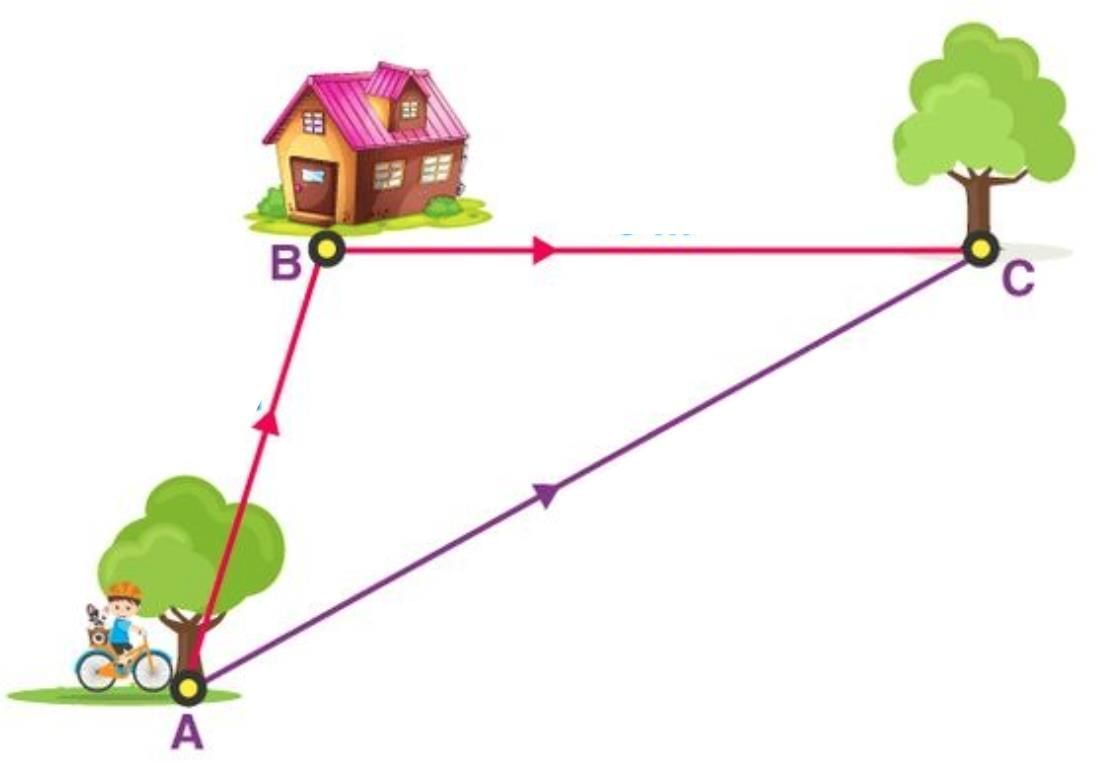
- A child starts from point A.
- He wants to reach the tree at point C.
- There are two possible routes:
- Route A → B → C: This goes through the house at B, then to C.
- Route A → C: This is a straight line from A to C.
Both routes reach the same place (C), but A → C is the shortest route because it is a direct path. This shows that the shortest route saves time and effort.
Coordinates
- Coordinates are a way to find the exact spot of something on a grid or map.
- They are written in brackets as (x, y).
- The first number (x) tells us the position along the row (left to right).
- The second number (y) tells us the position along the column (up and down).
- Example: If a point is at (3, 2), it means → go to Row 3 and then Column 2.
- Just like a house has an address, coordinates give the address of a place on a map.
Locating the Animals in the Zoological Park (Zoo)
Children observe a map of the zoo drawn on a grid. Each vertical line (column) and horizontal line(row) is marked with a number. To reach the Panda, we will start from zero. Move one step horizontally east and reach the first. column. Move up (vertically) one step north and reach the first row. The panda is where the first and the first column meet.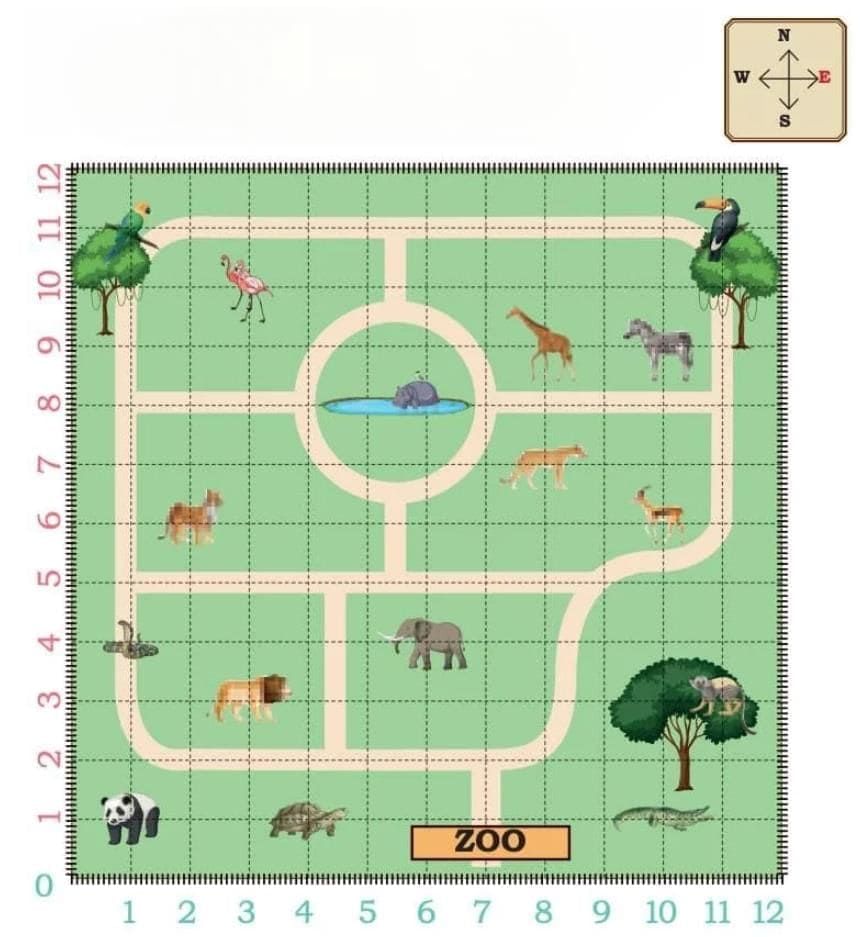
We write the meeting point of the first row and the first column as (1,1).
To reach the tortoise, move 4 steps towards the east and reach the fourth column.
Then move 1 step(s) north and reach the first row.
The location of the tortoise is (4,1). What is at (1,4)?
At (1,4) → there is a bird (crane/stork-like bird).
Answer the following questions now:
1. Locate the animal at the following positions on the map.
(a) (11,11) →Toucan bird
(b) (2,6) → Wolf
(c) (6,4) → Elephant
(d) (3,10) → Flamingo
(e) (11,3) → Crocodile
(f) (10,9) → Giraffe2. Write the position of the following animals on the map.
(a) Lion → (3,3)
(b) Elephant → (6,4)
(c) Tortoise → (4,1)
(d) Deer → (10,6)
(e) Panda → (1,1)
(f) Crocodile → (11,3)
We look at the zoo map like a big grid game. Each animal is sitting at the place where a row number and a column number meet. Just like playing Battleship! We can write the position as (x, y). That way, we can find any animal very easily.
|
35 videos|322 docs|7 tests
|
FAQs on Maps and Locations Chapter Notes - Mathematics (Maths Mela) Class 5 - New NCERT
| 1. What are the cardinal directions, and how can they help in finding directions? |  |
| 2. Why is it important to understand maps and locations in daily life? |  |
| 3. How can one use a compass to find directions? |  |
| 4. What are some common types of maps, and what do they show? |  |
| 5. How can landmarks assist in understanding locations and directions? |  |




















